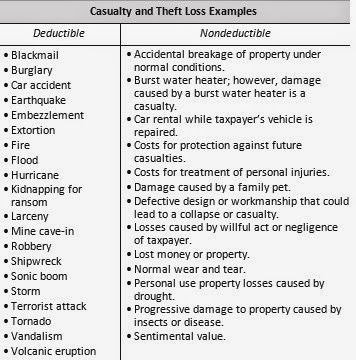A casualty loss is the damage, destruction, or loss of
property resulting from an identifiable event. The identifiable event must be:
• Sudden,
not gradual or progressive.
• Unexpected,
not ordinarily anticipated or intended.
• Unusual,
not a day-to-day occurrence or typical of the
taxpayer’s activity.
Theft Loss
A theft is the taking and removing of money or property
with the intent to deprive the owner of it. The taking of property must be:
• Illegal
under the law of the state where it occurred.
• Done
with criminal intent.
Deductible Amount of Losses
A non business casualty or theft loss is the lesser of the
taxpayer’s basis in the property damaged or destroyed, or the reduction in fair
market value due to the casualty or theft. From this amount, any insurance or
other reimbursement received, or that could have been received, if the taxpayer
chose not to file a claim is subtracted.
The casualty or theft loss is then reduced by $100 per
event when computing the deductible amount. Multiple items lost in a single
event result in only one $100 reduction. The total of all casualty and theft
losses from all events during the year is further reduced by 10% of the
taxpayer’s
adjusted gross income.
Criminal Fraud
Victims of criminal fraud or embezzlement related to a
transaction entered into for profit are allowed to deduct the theft loss as a
miscellaneous itemized deduction not subject to the 2% adjusted gross income
limitation. The deduction is also not subject to any other theft loss or
itemized deduction reductions or limitations.
Insurance
Losses are not deductible to the extent they are reimbursed
by insurance. If property is covered by insurance, a timely insurance claim for
reimbursement must be filed or the deduction is not allowed. The part of the
loss not covered by insurance is deductible. If a casualty loss is claimed in
one year, and in a later year the taxpayer receives reimbursement for the loss,
the deductible loss is not recomputed for the taxable year in which the
deduction was taken. Rather, the reimbursement amount is included in income in
the taxable year in which it was received.
Insurance proceeds used for living expenses are not
reimbursements for damages so amounts paid for normal living expenses are
generally taxable. However, payments to cover a temporary increase in living
expenses are excluded from income.
Note: If the
casualty occurs in a federally declared disaster area, none of the insurance
payments are taxable.
Gain on Reimbursement
If insurance or other reimbursement is more than the basis
in the property damaged or destroyed, the reimbursement is a gain. The gain is
taxable if a taxpayer does not use the proceeds to purchase replacement
property similar or related in service and use. The gain is postponed if:
• The
taxpayer purchases property that is similar or related to it in service or use
within two years of the end of the first
tax year in which any part of the gain
is realized (or acquires at least 80% of a corporation owning such property),
and
• The
cost of the replacement property is equal to or more than the reimbursement
received for the damaged, destroyed, or stolen property.
If the replacement property costs less than the
reimbursement, gain is recognized to the extent the reimbursement exceeds the
cost of the replacement property.
Federally-Declared Disaster Areas
A federally-declared disaster is a disaster determined by
the President to warrant federal government assistance. The 10% of adjusted
gross income limitation for casualty losses also applies to the portion of loss
due to a net disaster loss.
Year of Deduction for a
Federally-Declared Disaster Loss A taxpayer may elect to deduct a loss
in a federally-declared disaster area in the tax year immediately prior to the
disaster year. The return (or amended return) claiming the loss must be filed
by the later of: The due date for filing the original return (without
extensions) for the tax year in which the disaster occurred, or The due date
for filing the original return (including extensions) for the tax year
immediately prior to the tax year in which the disaster occurred. Items to
include on the tax return include the date of the disaster and the city, town,
county, and state in which the damaged or destroyed property was located.
Disaster Relief
Food, medical supplies, and other forms of assistance
received do not reduce the casualty loss, unless they are replacements for lost
or destroyed property. Qualified disaster relief payments received for expenses
incurred as a result of a federally declared disaster are not taxable income.
Cash Gifts for Disaster Victims
If a taxpayer receives a cash gift as a disaster victim
(such as gifts from relatives and neighbors) and there are no limits on how the
taxpayer can use the money, the gift is excluded from income. The casualty loss
is not reduced by the cash gift. This is true even if the cash gift is used to
help pay for repairs to property damaged in the disaster.
Casualty or theft losses are deductible in the year the
casualty occurred or the theft was discovered. If it is uncertain whether
insurance will reimburse all or a portion of the loss, do not deduct the
amounts of the loss in question until the tax year when it is reasonably certain
the loss will not be reimbursed.



